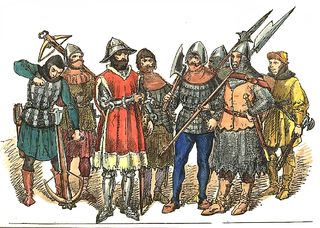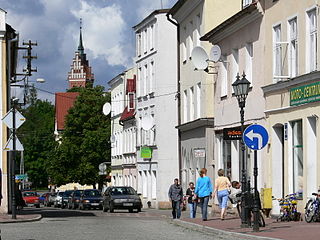
The Battle of Świecino also called the Battle of Żarnowiec or in German Die Schlacht bei Schwetz, took place on September 17, 1462 during the Thirteen Years' War. The Polish forces, commanded by Piotr Dunin and consisting of some 2,000 mercenaries and Poles, decisively defeated the 2,700-man army of the Teutonic Knights, commanded by Fritz Raweneck and Commander of the Order Kaspar Nostitz (Nostyc). Auxiliary forces sent by Duke Eric II of Pomerania, temporary ally of the Teutonic Knights, did not enter the battle.

The Teutonic Order is a Catholic religious institution founded as a military society c. 1190 in Acre, Kingdom of Jerusalem. The Order of Brothers of the German House of Saint Mary in Jerusalem was formed to aid Christians on their pilgrimages to the Holy Land and to establish hospitals. Its members have commonly been known as the Teutonic Knights, having historically served as a crusading military order for supporting Catholic rule in the Holy Land and the Northern Crusades during the Middle Ages, as well as supplying military protection for Catholics in Eastern Europe.
Year 1411 (MCDXI) was a common year starting on Thursday of the Julian calendar.

East Prussia was a province of the Kingdom of Prussia from 1772 to 1829 and again from 1878 ; following World War I it formed part of the Weimar Republic's Free State of Prussia, until 1945. Its capital city was Königsberg. East Prussia was the main part of the region of Prussia along the southeastern Baltic Coast.

Działdowopronounced[d͡ʑau̯ˈdɔvɔ] is a town in northern Poland with 20,935 inhabitants as of December 2021, the capital of Działdowo County. As part of Masuria, it is situated in the Warmian-Masurian Voivodeship, Działdowo belonged previously to Ciechanów Voivodeship (1975–1998). The town is a major railroad junction connecting the capital city of Warsaw with Gdańsk and Olsztyn to the north.

The Battle of Płowce took place on 27 September 1331 between the Kingdom of Poland and the Teutonic Order.

The siege of Belgrade, or siege of Nándorfehérvár was a military blockade of Belgrade that occurred 4–22 July 1456 in the aftermath of the fall of Constantinople in 1453 marking the Ottomans' attempts to expand further into Europe. Led by Sultan Mehmed II, the Ottoman forces sought to capture the strategic city of Belgrade, which was then under Hungarian control and was crucial for maintaining control over the Danube River and the Balkans.

The (First) Peace of Thorn was a peace treaty formally ending the Polish–Lithuanian–Teutonic War between allied Kingdom of Poland and Grand Duchy of Lithuania on one side, and the Teutonic Knights on the other. It was signed on 1 February 1411 in Thorn (Toruń), one of the southernmost cities of the Monastic State of the Teutonic Knights. In historiography, the treaty is often portrayed as a diplomatic failure of Poland–Lithuania as they failed to capitalize on the decisive defeat of the Knights in the Battle of Grunwald in June 1410. The Knights returned Dobrzyń Land which they captured from Poland during the war and made only temporary territorial concessions in Samogitia, which returned to Lithuania only for the lifetimes of Polish King Władysław Jagiełło and Lithuanian Grand Duke Vytautas. The Peace of Thorn was not stable. It took two other brief wars, the Hunger War in 1414 and Gollub War in 1422, to sign the Treaty of Melno that solved the territorial disputes. However, large war reparations were a significant financial burden on the Knights, causing internal unrest and economic decline. The Teutonic Knights never recovered their former might.

This is the 1409-1411 Polish-Lithuanian-Teutonic War. For a list of all Polish-German Wars, see Polish-German Wars.

Ryn is a town in northeastern Poland located 19 km southwest of Giżycko, in the Warmian-Masurian Voivodeship, in Masuria. Until the reorganization of 1999 it had been assigned to Suwałki Voivodeship. It had a population of 3,062 inhabitants as of December 31, 2004.

The Battle of Durbe was a medieval battle fought near Durbe, 23 km (14 mi) east of Liepāja, in present-day Latvia during the Livonian Crusade. On 13 July 1260, the Samogitians soundly defeated the joint forces of the Teutonic Knights from Prussia and the Livonian Order from Livonia. Some 150 knights were killed, including Livonian master Burkhard von Hornhausen and Prussian land marshal Heinrich Botel. It was by far the largest defeat of the knights in the 13th century: in the second-largest, the Battle of Aizkraukle, 71 knights were killed. The battle inspired the Great Prussian Uprising and the rebellions of the Semigallians, the Couronians, and the Oeselians. The battle undid two decades of Livonian conquests and it took some thirty years for the Livonian Order to restore its control.

The Prussian uprisings were two major and three smaller uprisings by the Old Prussians, one of the Baltic tribes, against the Teutonic Knights that took place in the 13th century during the Prussian Crusade. The crusading military order, supported by the Popes and Christian Europe, sought to conquer and convert the pagan Prussians. In the first ten years of the crusade, five of the seven major Prussian clans fell under the control of the less numerous Teutonic Knights. However, the Prussians rose against their conquerors on five occasions.

Górowo Iławeckie or simply Górowo, is a town in northern Poland, located in the Bartoszyce County, Warmian-Masurian Voivodeship, with 4,068 inhabitants (2016). The town has a land area of 3.32 square kilometres (1.28 sq mi) and is the smallest municipality (gmina) in terms of geographical size in Poland.

Ushakovo is a village in the Russian exclave Kaliningrad Oblast. It is situated at the mouth of the Prokhladnaya River at the Vistula Lagoon.

Polish–Teutonic Wars refer to a series of conflicts that took place between the Kingdom of Poland and the Teutonic Order, a medieval German military order with roots in the Baltic region. These wars occurred primarily during the 14th and 15th centuries and were characterized by territorial disputes, political maneuvering, and religious differences.

Slavskoye is a settlement in the Bagrationovsky District, Kaliningrad Oblast, Russia, located 20 kilometers (12 mi) south of Kaliningrad.

This is the 1454-1466 Polish-Teutonic War. For a list of all Polish-German Wars, see Polish-German Wars.

The Battle of Grunwald, Battle of Žalgiris, or First Battle of Tannenberg, was fought on 15 July 1410 during the Polish–Lithuanian–Teutonic War. The alliance of the Crown of the Kingdom of Poland and the Grand Duchy of Lithuania, led respectively by King Władysław II Jagiełło (Jogaila), and Grand Duke Vytautas, decisively defeated the German Teutonic Order, led by Grand Master Ulrich von Jungingen. Most of the Teutonic Order's leadership was killed or taken prisoner.
Siege of Marienburg occurred during the Thirteen Years' War between the Teutonic Knights and the Kingdom of Poland. Marienburg was the capital of the state of the Teutonic Order, in particular, the residence of the Grand Master of the order. An alliance of Prussians and Poles besieged the city beginning 27 February 1454 with mercenaries from Danzig, and the necessary artillery.

Ryn Castle is a fourteenth-century castle located between Ryn and Ołów Lake, by Liberty Square in Ryn, Poland.














